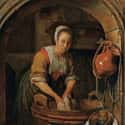-
(#12) Body Odor In Women Was Thought To Be A Mechanism Of Self-Defense
Attitudes about bathing during the colonial period in America were not uniform, but some of the country's Founding Fathers were clear in how they viewed the cleanliness of women. Thomas Jefferson, for example, told his daughter, Martha, "nothing is so disgusting to our sex as a want of cleanliness and delicacy in yours."
Doctors in the late 18th century advised women to bathe, in large part to cure illnesses that affected female reproductive organs. While Thomas Ewell, a doctor from Virginia, acknowledged the prevailing wisdom that women "were so constituted as to become offensive to the nose... for the purpose of suppressing too ardent devotion of males," cleanliness was of the higher order. Women may use smell as "a [means of] defense... to ensure protection, by rendering themselves as disgusting as possible," but the stench was offensive to all women.
-
(#7) Lye Soap Was Used For Clothing And Dishes, Not For Personal Care
Wealthy colonists may have imported fragrant soaps from Europe, but most colonists made their own soap or purchased it locally. Lye soap - made from a mixture of animal fat, lye, and ash - in colonial America was harsh and used only to clean clothes, dishes, and parts of the home. Lye soap was made with little regard for measuring, and the process itself was time-consuming and smelly.
The use of lye soap made doing laundry in colonial American that much more difficult. The harsh concoction, combined with hauling water, heating fires, wringing clothes, and hanging items to dry, added to the already exhausting task. As a result, only clothes that got the dirtiest - underwear, aprons, diapers - were washed with any amount of regularity.
-
(#3) Teeth Could Be Pulled By Any Number Of People
With no real dentists in colonial America, having a tooth that needed to be pulled meant a visit to the barber, surgeon, apothecary, or even the blacksmith. To deal with toothaches before such an intervention was needed, people used natural remedies like figs, chamomile, alcohol, and opium to numb the pain.
There was little concern for keeping teeth clean while they were still in one's mouth, although replacing a pulled tooth was common. At times, the extracted tooth would simply be put back into the socket.
More commonly, dentures and implants were used. New teeth were taken from poor individuals willing to sell their healthy chompers, wood was shaped to fit, or ivory and metal were used. The most famous denture-wearer of the colonial period, George Washington, wore dentures made out of metal, wire, and animal teeth. His mouthpiece, however, constantly caused him pain and distorted the shape of his face.
-
(#6) Early Colonists Had A Single Tool To Clean Their Ears And Teeth
Archaeologists discovered a silver earpicker at the site of the original fort at Jamestown during the 1990s. The instrument, which dates to the early decades of the 17th century, had a pointed pick at one end with a small scooping tool at the other. Earpicks were used as toothpicks, to clean out one's fingernails, and for a variety of hygienic tasks.
The spoon-like side of the earpicker may have been used to remove earwax, but it also proved useful in collecting the valuable material. In lieu of beeswax, earwax was applied to thread to prevent unraveling.
-
(#9) The Earliest Settlers Complained About 'Vermin'
Captain John Smith (1580-1631), explorer, settler, and key figure in the administration of the Jamestown colony, wrote extensively about his impressions of the Americas. He described noisy creatures, notably "musketas and flies" and "a certaine India Bug, called by the Spaniards a Cacarooch, the which creeping into Chests they eat and defile with their ill-sented dung." He also called ants troublesome.
Colonists endured lice as well, with George Washington (1732-1799) commenting that his blanket was full of "double its Weight of Vermin such as Lice, Fleas, etc." A young man on an exploratory trip through the Shenandoah Valley in 1748, Washington found himself in a bug-infested cabin. He learned his lesson, however, sleeping outside and close to the fire on future outings.
Christian missionary George Henry Loskiel had a bigger problem with bugs, "a troublesome plague to both man and beast" called "living ashes." Natives gave them the name because, according to Loskiel, their bites were "as painful as the burning of red-hot ashes."
-
(#1) Bathing Was Done With A Wet Cloth And A Pail Of Water
Full-body baths were uncommon during the 17th and 18th centuries, and it was usually only given to infants - not necessarily to clean them but rather to "harden" them. Men, women, and children rinsed their faces and hands each morning but, when it came to bathing, there wasn't much more involved. Individuals would use a basin, cloth, and maybe a sponge, wiping themselves off wherever they could find privacy. Baths could be relatively common, but soap was not used.
Another technique was swimming, but dips in a nearby stream or lake were more for cooling off rather than getting clean.
Bathtubs, reserved only for those who could afford them, were often only large enough for a sponge bath.
New Random Displays Display All By Ranking
About This Tool
As we all know, the history of colonial America was dark and brutal. Numerous slaves were trafficked to the American continent, where they could not get basic survival guarantees and medical and health care. We all know that frequent hand washing is the key to preventing the spread of diseases. But looking back at the history of colonial America, many people even took a bath only a few times a year at that time.
This means that the health situation of the early Americans was worse. For the early American colonists, hygiene basically was meaningless. The random tool shares 12 disgusting facts about hygiene In colonial America.
Our data comes from Ranker, If you want to participate in the ranking of items displayed on this page, please click here.
















